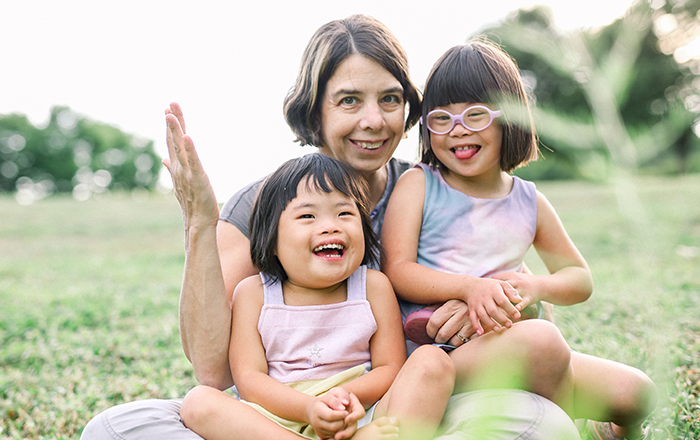HERITAGE CAMP: Culture and Camaraderie
by Katherine Mikkelson
Heritage camps, also called culture camps, seek to connect adopted children with their roots by introducing them to age-appropriate music, dance, folktales, holidays, food, fashion, language, and history in a fun and supportive environment. My two boys, both from South Korea, loved attending Camp Mujigae, in Albany, New York. My then-six-year-old Zack enjoyed the mandu (dumplings) at camp so much that he made them with his schoolmates for Korean New Year.
Preschoolers at a Russian camp might color pieces of a troika puzzle picturing the classic Russian sleigh pulled by three horses. Grade-schoolers might play games or learn phrases in the language of their birth country. Middle-school kids might play folk instruments or learn about their country’s history.
While cultural activities may be the draw for younger children, camps let older children find camaraderie in a relaxed setting. For children who live in homogenous communities, camp may be the only place they interact with other kids of the same ethnicity and families like their own.
There are as many camp styles as there are cultures they serve. Some camps meet for two days over a weekend; others last a week. There are day and sleep-away camps. Some are community-based, perhaps at a local school; others have the traditional “outdoorsy” feel. Parent involvement tends to be heaviest at programs for young children, tapering off as children get older. And depending on their philosophy, programs sometimes add adoption workshops to the heritage theme.
Many parents rely on camps for birth-country information that they don’t have access to. To this end, camps strive to make the experiences genuine, engaging adoptees or natives of the culture as teachers. “I can’t give enough credit to the local cultural communities,” says Pam Sweetser, executive director of Colorado Heritage Camps, which runs more than 10 camps for different ethnicities. “It’s important that we stay authentic, and the community groups make sure we do that.”
Unlike conventional kids’ camps, many heritage camps stress family participation. They offer parents workshops and classes in craft-making as well as adoption issues. White parents of African-American children might learn about black hair and skin care. Many camps depend on parent volunteers, so parents may be asked to tell stories, help children with crafts, cook, and clean up.
Marissa Martin was a long-time camper at a Holt Heritage Camp. (Holt has facilities in California, Georgia, New Jersey, Oregon, and Wisconsin.) She went on to serve as a counselor and an assistant director. Martin said that after attending camp, at age 14, “I was so proud to be adopted. Questions like, ‘Why is your last name Martin?’ and ‘Why don’t you speak Korean?’ didn’t bother me anymore. Holt camp has helped me get through so much in my life.”
HOMELAND TOUR: Feeling At Home, Abroad
by Lehea Potter Kuphal
We’d talked with our sons about returning to Central America one day. When the boys were 11 and 10, we thought they were old enough to withstand the rigors of international travel and to appreciate their birth cultures. And we wanted to make the trip before the identity-building teenage years.
We felt it was important for our sons to share the experience with other children and families like ours, so we chose to travel to Guatemala on one of The Ties Program’s tours for adoptive families.
Our trip brought a wonderfully diverse set of activities. Among the highlights: visiting a zoo and children’s museum in Guatemala City, taking a boat across Lake Atítlan, and climbing the Mayan ruins of Tikal. We visited an orphanage in Zaragoza run by a dedicated Costa Rican nun, as well as a school/clinic run by a retired minister in Guatemala City. In Chichicastenango, our boys played basketball and soccer at a local school, and we enjoyed a delicious meal and lots of joking, in both Spanish and English, on a visit with a family. We did see poverty, but our children also saw middle-class families on vacation, shopping in the markets–doing the same things we do back home. They came away understanding that families and kids around the world are more alike than different.
Finally, they had the powerful experience of walking down a street where, for once, everyone looked like them! Everyone we met was friendly and supportive of–if occasionally perplexed by–our decision to adopt Guatemalan children.
One of the trip’s highlights came on our last night in Guatemala City, at a beautiful restaurant with Mayan décor, lit by candles. Our children, some dressed in Mayan garb, were chattering away to one another. A young American at a nearby table looked over and commented on how perfectly our group of Guatemalan children spoke English. When I explained why, he pronounced our visit back to their homeland “very cool.” An organized homeland tour is indeed a cool way for children to connect with their heritage.
NO PASSPORT REQUIRED
Take a day trip to a nearby city and visit its ethnic neighborhoods. Many are walkable, and full of restaurants and markets where you can soak up the language and culture. If your kids are old enough to appreciate the history of the area, see if tours are available. For example, the Museum of Chinese in America, in New York’s Chinatown, offers walking tours. If you haven’t booked your summer vacation yet, consider including one of these neighborhoods in your trip:
- Chinatown, San Francisco
- Little India, Chicago
- Jackson Heights, Queens, New York (large Colombian and Indian communities)
- Koreatown, Los Angeles
- Little Ethiopia, Washington, DC
- San Antonio, Texas (large Hispanic community)
- Brighton Beach, Brooklyn, New York (large Russian community)
- San Jose, California (large Vietnamese community)
BIRTH CITY TRIP: Honoring a Hyphenated Heritage
by Leslie Kizner
My Long Island-raised daughter and I have always talked about her birth city of San Antonio, Texas. Though she speaks with a New York accent, she is proud of her Mexican-American background.
By the time she was 10, her curiosity had blossomed. We know very little about her birth–she was escorted to New York from Texas at five days old–so I was curious about her birth city, as well. With the clear understanding that we would visit to learn about her roots, not to search for her birth parents, we planned a trip to San Antonio.
In San Antonio, we did the usual tourist things–visited the Alamo, strolled the Riverwalk–all the while learning about Texas history and exploring the city’s thriving Mexican culture. Emily relished the Tex-Mex food (the spicier the better), and bought a cowboy hat that she wore throughout our stay. We had never been to a city with such a large Hispanic population. Emily’s was one of many Hispanic faces. It was hard to keep track of her as she ran from activity to activity.
In the city of her birth, it was impossible not to think of her birth family. A few blocks from our hotel stood the county courthouse where Emily’s adoption had been finalized. Somewhere, buried in a file room in that building, was information about Em’s origins–so close, yet unavailable to us because of closed adoption records.
Three days into our trip, at Emily’s request, we visited the adoption agency. When we got there, Emily went into a quiet mode. Finally, she asked one question: “Was I ever in this room?” The answer told us something about the first five days of her life: Yes, she had been there, on her way from foster care to the airport. Another thought played in my head: Her birth mom had been in that room once, too. I felt closer to her than ever before. Since the visit, Emily has had a new calm about her. Being part of the majority culture, even for a few days, was a powerful experience for Emily. She talks about moving to Texas when she is an adult, and kids me about my trying to find her among all those Hispanic faces. Pride in her city and heritage has been important to her sense of self. We hope to return to Texas soon.
HOSTING AN EXCHANGE STUDENT: A Positive, Personal Role Model
by Marianna Haas
Living in a small, Midwestern town, where the Asian population is minute, it’s hard to participate in cultural activities as we’d like to. For financial reasons, I didn’t want to move to a new town or neighborhood, and I felt uncomfortable seeking out friendships with people purely because they were Chinese. Having a Chinese student live with us seemed to be a good solution to our cultural isolation.
When my daughters were seven, four, and three, our agency called, saying a Chinese high school student needed a place to live. And so began a great nine months.
Yuka didn’t teach us Chinese language, traditions, or cooking; rather, we Americanized her. She enjoyed activities she’d never done before, such as painting a room, baking (most homes in China don’t have ovens), mowing grass, and gardening. She announced right away that she didn’t like rice. What she did provide, however, was an excellent role model. My daughters absorbed her actions, unconsciously thinking, “This is what I will grow up to look like; these are the things I will grow up to do.”
Yuka also connected us to the local Chinese-American community. We were invited to a Chinese New Year dinner and to play dates. I met local teenagers who translated for their non-English-speaking parents and worked long hours at their family businesses.
We were all sad when we had to say good-bye to Yuka. For months, my youngest two didn’t understand why she left; she had become their big sister, and, in a sense, I had gained a fourth daughter from China. Not all international student experiences may be as good as ours was, but it worked well for us.



